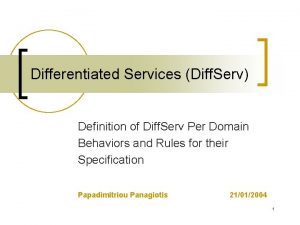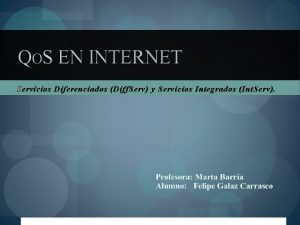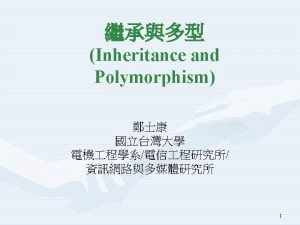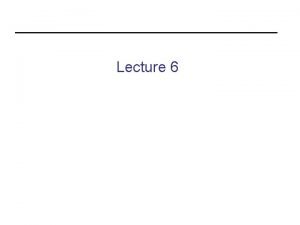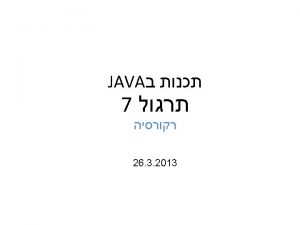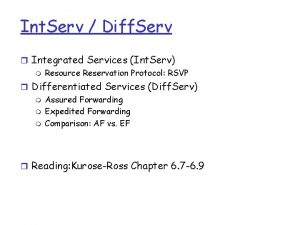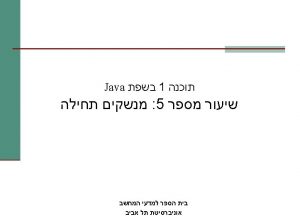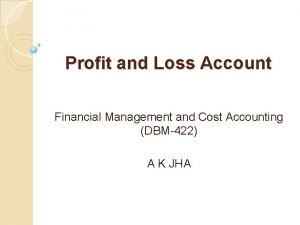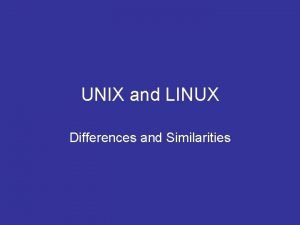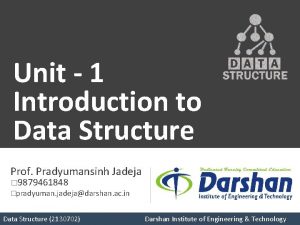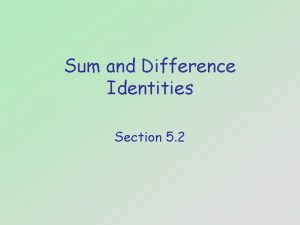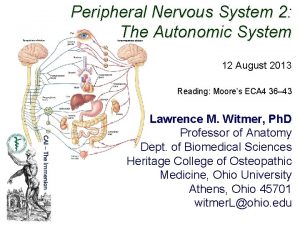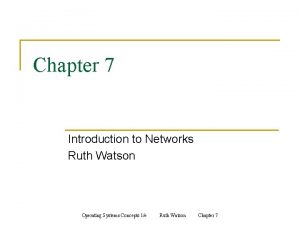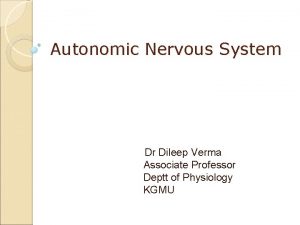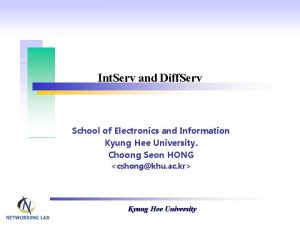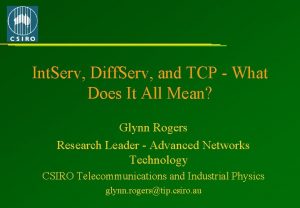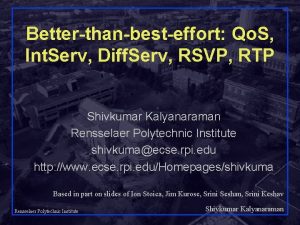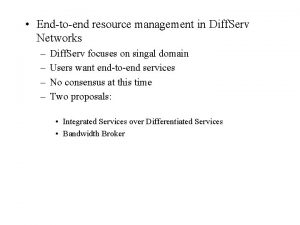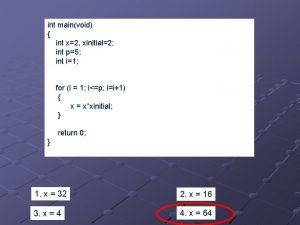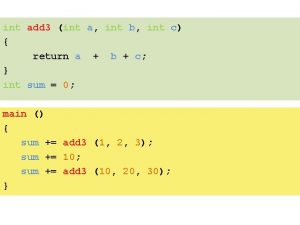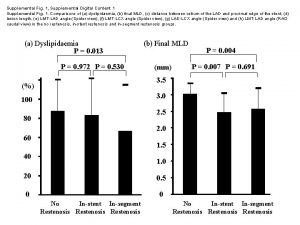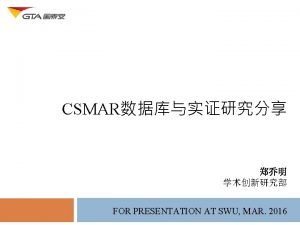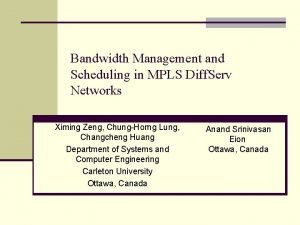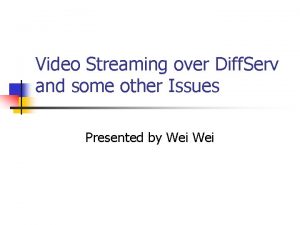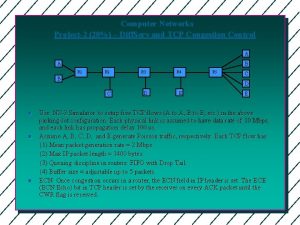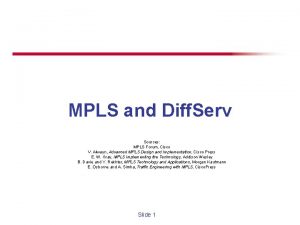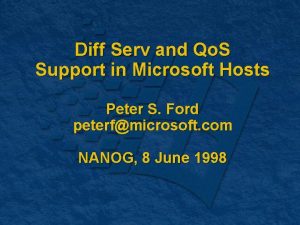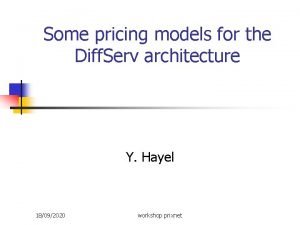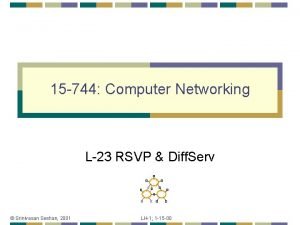Qo S Int Serv and Diff Serv Supplemental









































- Slides: 41

Qo. S: Int. Serv and Diff. Serv Supplemental Slides Aditya Akella 02/26/2007

Motivation • Internet currently provides one single class of “best-effort” service – No assurances about delivery • Existing applications are elastic – Tolerate delays and losses – Can adapt to congestion • Future “real-time” applications may be inelastic

Inelastic Applications • Continuous media applications – Lower and upper limit on acceptable performance. – BW below which video and audio are not intelligible – Internet telephones, teleconferencing with high delay (200 - 300 ms) impair human interaction • Hard real-time applications – Require hard limits on performance – E. g. control applications

Why a New Service Model? • What is the basic objective of network design? – Maximize total bandwidth? Minimize latency? – Maximize user satisfaction – the total utility given to users • What does utility vs. bandwidth look like? – Must be non-decreasing function – Shape depends on application

Utility Curve Shapes U Elastic BW U U Hard real-time BW Delay-adaptive Stay to the right and you are fine for all curves BW

Utility curve – Elastic traffic U Elastic Bandwidth Does equal allocation of bandwidth maximize total utility?

Admission Control • If U(bandwidth) is concave elastic applications U – Incremental utility is decreasing with increasing bandwidth – Is always advantageous to have more flows with lower bandwidth • No need of admission control; This is why the Internet works! Elastic BW

Utility Curves – Inelastic traffic U Delay-adaptive BW U Hard real-time BW Does equal allocation of bandwidth maximize total utility?

Admission Control • If U is convex inelastic applications – U(number of flows) is no longer monotonically increasing – Need admission control to maximize total utility • Admission control deciding when the addition of new people would result in reduction of utility – Basically avoids overload U Delay-adaptive BW

Components of Integrated Services 1. Type of commitment What does the network promise? 2. Packet scheduling How does the network meet promises? 3. Service interface How does the application describe what it wants? 4. Establishing the guarantee How is the promise communicated to/from the network not covered (see RSVP paper if curious) How is admission of new applications controlled?

1. Type of commitment What kind of promises/services should network offer? Depends on the characteristics of the applications that will use the network ….

Playback Applications • Sample signal packetize transmit buffer playback – Fits most multimedia applications • Performance concern: – Jitter – variation in end-to-end delay • Delay = fixed + variable = (propagation + packetization) + queuing • Solution: – Playback point – delay introduced by buffer to hide network jitter

Characteristics of Playback Applications – In general lower delay is preferable. – Doesn’t matter when packet arrives as long as it is before playback point – Network guarantees (e. g. bound on jitter) would make it easier to set playback point – Applications can tolerate some loss

Applications Variations • Rigid & adaptive applications – Rigid – set fixed playback point – Adaptive – adapt playback point • Gamble that network conditions will be the same as in the past • Are prepared to deal with errors in their estimate • Will have an earlier playback point than rigid applications • Tolerant & intolerant applications – Tolerance to brief interruptions in service • 4 combinations

Applications Variations Really only two classes of applications 1) Intolerant and rigid 2) Tolerant and adaptive Other combinations make little sense 3) Intolerant and adaptive - Cannot adapt without interruption 4) Tolerant and rigid - Missed opportunity to improve delay So what service classes should the network offer?

Type of Commitments • Guaranteed service – For intolerant and rigid applications – Fixed guarantee, network meets commitment as long as clients send at match traffic agreement • Predicted service – For tolerant and adaptive applications – Two components • If conditions do not change, commit to current service • If conditions change, take steps to deliver consistent performance (help apps minimize playback delay) • Implicit assumption – network does not change much over time • Datagram/best effort service

Components of Integrated Services 1. Type of commitment What does the network promise? 2. Packet scheduling How does the network meet promises? 3. Service interface How does the application describe what it wants? 4. Establishing the guarantee How is the promise communicated to/from the network How is admission of new applications controlled?

Scheduling for Guaranteed Traffic – Use token bucket filter to characterize traffic • Described by rate r and bucket depth b – Use WFQ at the routers – Parekh’s bound for worst case queuing delay = b/r

Token Bucket Filter Tokens enter bucket at rate r Operation: – If bucket fills, tokens are discarded – Sending a packet of size P Bucket depth b: capacity of bucket uses P tokens – If bucket has P tokens, packet sent at max rate, else must wait for tokens to accumulate

Token Bucket Operation Tokens Overflow Packet Enough tokens packet goes through, tokens removed Packet Not enough tokens wait for tokens to accumulate

Token Bucket Characteristics • On the long run, rate is limited to r • On the short run, a burst of size b can be sent • Amount of traffic entering at interval T is bounded by: – Traffic = b + r*T • Information useful to admission algorithm

Guarantee Proven by Parekh • Given: – Flow i shaped with token bucket and leaky bucket rate control (depth b and rate r) – Network nodes do WFQ • Cumulative queuing delay Di suffered by flow i has upper bound – Di < b/r, (where r may be much larger than average rate) – Assumes that r < link speed at any router – All sources limiting themselves to r will result in no network queuing

Predicted Service Goals: • Isolation – Isolates well-behaved from misbehaving sources • Sharing – Mixing of different sources in a way beneficial to all Mechanisms: • WFQ – Great isolation but no sharing • FIFO – Great sharing but no isolation

Predicted Service • FIFO jitter increases with the number of hops – Use opportunity for sharing across hops • FIFO+ – At each hop: measure average delay for class at that router – For each packet: compute difference of average delay and delay of that packet in queue – Add/subtract difference in packet header – Packet inserted into queues expected arrival time instead of actual • More complex queue management! • Slightly decreases mean delay and significantly decreases jitter

Unified Scheduling • Assume 3 types of traffic: guaranteed, predictive, best-effort • Scheduling: use WFQ in routers • Each guaranteed flow gets its own queue • All predicted service flows and best effort aggregates in single separate queue – Predictive traffic classes • Multiple FIFO+ queues • Worst case delay for classes separated by order of magnitude • When high priority needs extra bandwidth – steals it from lower class – Best effort traffic acts as lowest priority class

Service Interfaces • Guaranteed Traffic • Host specifies rate to network • Why not bucket size b? • If delay not good, ask for higher rate • Predicted Traffic – – Specifies (r, b) token bucket parameters Specifies delay D and loss rate L Network assigns priority class Policing at edges to drop or tag packets • Needed to provide isolation – why is this not done for guaranteed traffic? – WFQ provides this for guaranteed traffic

Diff. Serv • Best-effort expected to make up bulk of traffic, but revenue from first class important to economic base (will pay for more plentiful bandwidth overall) • Not motivated by real-time! Motivated by economics and assurances

Basic Architecture • Agreements/service provided within a domain – Service Level Agreement (SLA) with ISP • Edge routers do traffic conditioning – Perform per aggregate shaping and policing – Mark packets with a small number of bits; each bit encoding represents a class or subclass • Core routers – Process packets based on packet marking and defined per hop behavior • More scalable than Int. Serv – No per flow state or signaling

Per-hop Behaviors (PHBs) • Define behavior of individual routers rather than end-to-end services – there may be many more services than behaviors • Multiple behaviors – need more than one bit in the header • Six bits from IP TOS field are taken for Diffserv code points (DSCP)

Per-hop Behaviors (PHBs) • Two PHBs defined so far • Expedited forwarding aka premium service (type P) – Possible service: providing a virtual wire – Admitted based on peak rate – Unused premium goes to best effort • Assured forwarding (type A) – Possible service: strong assurance for traffic within profile & allow source to exceed profile – Based on expected capacity usage profiles – Traffic unlikely to be dropped if user maintains profile – Out-of-profile traffic marked

Expedited Forwarding PHB • User sends within profile & network commits to delivery with requested profile – Signaling, admission control may get more elaborate in future • Rate limiting of EF packets at edges only, using token bucket to shape transmission • Simple forwarding: classify packet in one of two queues, use priority – EF packets are forwarded with minimal delay and loss (up to the capacity of the router)

Expedited Forwarding Traffic Flow Company A Packets in premium flows have bit set internal router host first hop router Unmarked packet flow Premium packet flow restricted to R bytes/sec ISP edge router

Assured Forwarding PHB • User and network agree to some traffic profile – Edges mark packets up to allowed rate as “in-profile” or low drop precedence – Other packets are marked with one of 2 higher drop precedence values • A congested DS node tries to protect packets with a lower drop precedence value from being lost by preferably discarding packets with a higher drop precedence value – Implemented using RED with In/Out bit

Red with In or Out (RIO) • Similar to RED, but with two separate probability curves • Has two classes, “In” and “Out” (of profile) • “Out” class has lower Minthresh, so packets are dropped from this class first – Based on queue length of all packets • As avg queue length increases, “in” packets are also dropped – Based on queue length of only “in” packets

RIO Drop Probabilities P (drop out) P (drop in) P max_out P max_in min_in max_in avg_in min_out max_out avg_total

Edge Router Input Functionality Fl Arriving packet ow N Flow 1 Traffic Conditioner 1 Packet classifier Traffic Conditioner N Best effort Forwarding engine classify packets based on packet header

Traffic Conditioning Drop on overflow Packet input Wait for token Set EF bit Packet output No token Packet input Test if token Set AF “in” bit Packet output

Output Forwarding • 2 queues: EF packets on higher priority queue • Lower priority queue implements RED “In or Out” scheme (RIO)

Router Output Processing What DSCP? EF High-priority Q Packets out AF If “in” set incr in_cnt Low-priority Q RIO queue management If “in” set decr in_cnt

Edge Router Policing AF “in” set Arriving packet Is packet marked? Token available? no Clear “in” bit Forwarding engine Not marked EF set Token available? no Drop packet

Comparison Best-Effort Service • Connectivity • No isolation • No guarantees Diffserv Intserv • Per aggregation isolation • Per aggregation guarantee • Per flow isolation • Per flow guarantee Service Scope • End-to-end • Domain • End-to-end Complexity • No set-up • Long term setup • Per flow setup Scalability • Highly scalable • (nodes maintain only routing state) • Scalable (edge • Not scalable (each routers maintains router maintains per aggregate state; per flow state) core routers per class state)
 Sum0
Sum0 Diff in diff regression
Diff in diff regression Serv definition
Serv definition Diff serv
Diff serv Int max(int x int y)
Int max(int x int y) Interface calculator public int add(int a int b)
Interface calculator public int add(int a int b) Public void drawsquare(int x, int y, int len)
Public void drawsquare(int x, int y, int len) Public int divide(int a int b)
Public int divide(int a int b) Int serv
Int serv Interface myinterface int foo(int x)
Interface myinterface int foo(int x) Int main int argc char argv
Int main int argc char argv Int factorial(int n)
Int factorial(int n) Arduino constant int
Arduino constant int Int main int num 4
Int main int num 4 Voidswap
Voidswap Void f(int i) int j=0
Void f(int i) int j=0 Int max int min c++
Int max int min c++ Int main int argc char argv
Int main int argc char argv Correction of errors
Correction of errors Explain profit and loss account
Explain profit and loss account Similarities between linux and unix
Similarities between linux and unix Difference between virtual circuit and datagram
Difference between virtual circuit and datagram Optical fibre
Optical fibre How to calculate time complexity in data structure
How to calculate time complexity in data structure Sum and diff identities
Sum and diff identities Sympathetic and parasympathetic nervous system difference
Sympathetic and parasympathetic nervous system difference Kawasaki vs scarlet fever
Kawasaki vs scarlet fever Diff between primary and secondary battery
Diff between primary and secondary battery Diff between workgroup and domain
Diff between workgroup and domain Single mode fiber supports meridional rays
Single mode fiber supports meridional rays Lead acid battery primary or secondary
Lead acid battery primary or secondary Diff between sympathetic and parasympathetic
Diff between sympathetic and parasympathetic Diff between sympathetic and parasympathetic
Diff between sympathetic and parasympathetic Difference between a* and ao* algorithm
Difference between a* and ao* algorithm Difference of ratio and proportion
Difference of ratio and proportion What is the difference between jig and fixture
What is the difference between jig and fixture Diff between prismatic and surveyor compass
Diff between prismatic and surveyor compass Biochemistry
Biochemistry Diff between prokaryotes and eukaryotes
Diff between prokaryotes and eukaryotes Differences between prokaryotic and eukaryotic cells
Differences between prokaryotic and eukaryotic cells Diff between hexokinase and glucokinase
Diff between hexokinase and glucokinase


